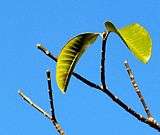Tabernaemontana elegans
| Tabernaemontana elegans | |
|---|---|
 | |
| warty fruit, holding numerous seeds | |
| Scientific classification | |
| Kingdom: | Plantae |
| (unranked): | Angiosperms |
| (unranked): | Eudicots |
| (unranked): | Asterids |
| Order: | Gentianales |
| Family: | Apocynaceae |
| Genus: | Tabernaemontana |
| Species: | T. elegans |
| Binomial name | |
| Tabernaemontana elegans Stapf | |
| Synonyms[1] | |
| |
Tabernaemontana elegans is a shrub or small tree that is native to eastern Africa. Vernacular names for the plant include "Toad tree".
Structure
It grows up to 15 metres (49 ft) tall, with a trunk diameter of up to 30 centimetres (12 in). Its fragrant flowers feature white, creamy or pale yellow corolla lobes. Fruit consists of 2 separate ovoid or ellipsoid pods, up to 8 centimetres (3.1 in) each.
Range
Habitat is in forests or bushland from sea-level to 1,000 metres (3,300 ft) altitude. The plant is native to Somalia, Kenya, Tanzania, Mozambique, Zimbabwe, Swaziland and South Africa.[2][3][4]
Uses
Its numerous local medicinal uses include the treatment of heart disease, cancer, tuberculosis and venereal diseases. T. elegans is also used as an aphrodisiac.[2] The Zulu name for this genus, iNomfi, refers to the use of their sticky, milky latex as bird-lime.[5]
Chemistry
Fourteen indole alkaloids have been isolated in the callus culture of Tabernaemontana elegans (isovoacangine, 3-R/S-hydroxy-isovoacangine, 3-R/S-hydroxy-coronaridine, isositsirikine, geissoschizol, tabernaemontanine, vobasine, vobasinol, apparicine, 16-hydroxy-16,22-dihydro-apparicine, tubotaiwine, 3-R/S-hydroxy-conodurine and monogagaine) of which apparicine is the principal.[6]
|
References
- ↑ "Tabernaemontana elegans". The Plant List. Retrieved 4 August 2013.
- 1 2 Medicinal Plants. PROTA. 2008. pp. 592–593. ISBN 978-9-05782-204-9.
- ↑ "Tabernaemontana elegans". Flora of Zimbabwe. Retrieved 4 August 2013.
- ↑ "Tabernaemontana elegans". Encyclopedia of Life. Retrieved 4 August 2013.
- ↑ Palmer, Eve (1977). A Field Guide to the Trees of Southern Africa. London, Johannesburg: Collins. pp. 303–304. ISBN 0-620-05468-9.
- ↑ Indole alkaloids from a callus culture ofTabernaemontana elegans. R. van der Heijden, R.L. Brouwer, R. Verpoorte, R. Wijnsma, T.A. van Beek, A.A. Harkes and A. Baerheim Svendsen, Phytochemistry, Volume 25, Issue 4, doi:10.1016/0031-9422(86)80013-9
| Wikimedia Commons has media related to Tabernaemontana elegans. |
| Wikispecies has information related to: Tabernaemontana elegans |

